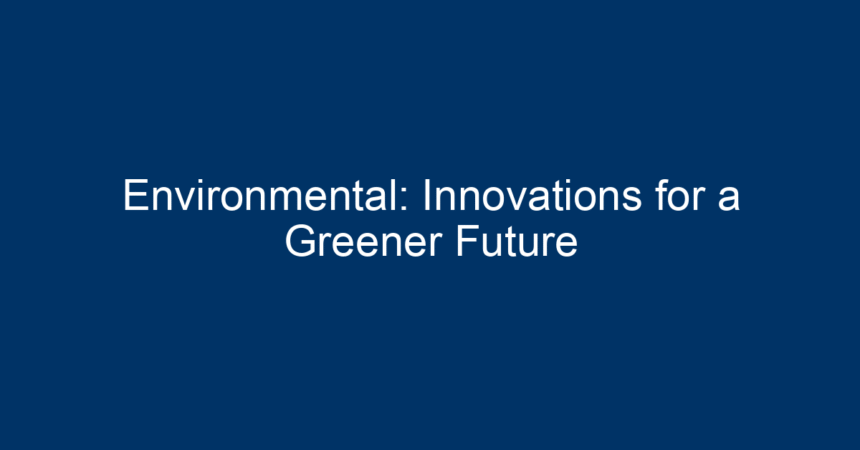In an era where climate change and environmental degradation loom large, the need for innovative solutions has never been more critical. From renewable energy technologies to sustainable agriculture practices, the quest for a greener future is gaining momentum. This article explores various environmental innovations that are paving the way for a more sustainable world. By understanding these advancements, we can all contribute positively to the planet’s health.
The Urgency of Environmental Action
The science is clear: our planet is in crisis. Rising global temperatures, changing weather patterns, and biodiversity loss demand immediate and innovative responses. Every year, environmental disasters become more frequent and severe, urging governments, businesses, and individuals to reconsider their approaches to sustainability.
Why Innovations Matter
Innovations are crucial in transitioning to a more sustainable future. They not only provide effective solutions to pressing environmental issues but also create economic opportunities. By investing in innovative technologies, communities can grow sustainably while protecting their natural resources.
Renewable Energy Technologies
Solar Power
Solar energy is one of the most accessible renewable resources available today. Photovoltaic (PV) cells convert sunlight into electricity, and the technology has become increasingly efficient over the years. Innovations in solar panel manufacturing, such as the development of bifacial panels and building-integrated photovoltaics (BIPV), are enhancing solar energy’s viability.
Benefits of Solar Energy
- Cost-effective: The cost of solar panels has dropped significantly, making them an attractive investment for both homeowners and businesses.
- Energy independence: Utilizing solar power reduces reliance on fossil fuels, contributing to national energy security.
- Environmental protection: Solar energy generates negligible emissions, helping combat climate change.
Wind Energy
Wind energy is another significant player in the renewable sector. Advancements in turbine technology, including larger rotors and improved materials, are increasing efficiency and energy output.
Benefits of Wind Energy
- Sustainable power generation: Wind energy has the potential to produce vast amounts of electricity without depleting natural resources.
- Job creation: As the wind energy sector expands, it generates numerous job opportunities in construction, maintenance, and engineering.
- Reduction of greenhouse gas emissions: Wind energy contributes to a decrease in harmful emissions, fostering a cleaner atmosphere.
Sustainable Agriculture Practices
AgTech Innovations
Agricultural technology (AgTech) is revolutionizing how food is produced. Innovations such as precision farming, which uses data analytics and IoT devices, allow farmers to optimize yields while minimizing resource use.
Benefits of Sustainable Agriculture
- Resource efficiency: Precision farming reduces water and fertilizer usage, leading to a lower environmental impact.
- Enhanced crop resilience: Innovative practices can help crops better withstand pests and climate variability.
- Food security: By optimizing production, sustainable agriculture supports global food supply, which is crucial as the population grows.
Urban Agriculture
Urban agriculture practices, including vertical farming and rooftop gardens, are surfacing in cities worldwide. These innovations enable communities to grow their food locally, reducing the carbon footprint associated with transportation.
Benefits of Urban Agriculture
- Community engagement: Urban gardens foster community ties and promote awareness of where food comes from.
- Improved air quality: Plants absorb CO2 and other pollutants, enhancing urban environments.
- Reduced food miles: Local food production minimizes the environmental impact associated with transporting food over long distances.
Waste Management Innovations
Circular Economy
The circular economy promotes the reuse and recycling of materials to minimize waste. Innovations in product design and resource recovery techniques are central to this approach.
Benefits of a Circular Economy
- Waste reduction: By rethinking product life cycles, companies can significantly reduce landfill waste.
- Conservation of resources: Using reclaimed materials conserves natural resources and reduces environmental degradation.
- Economic growth: A shift towards a circular economy can open new markets and opportunities.
Composting Technologies
Innovations in composting have made it easier for households and businesses to process organic waste. Advanced composting systems can handle food scraps and yard waste, turning them into nutrient-rich soil amendments.
Benefits of Composting
- Soil health: Compost enhances soil structure and fertility, promoting healthy plant growth.
- Waste diversion: Composting reduces the volume of waste sent to landfills, mitigating methane emissions.
- Resource recycling: This practice closes the nutrient loop, returning organic matter to the soil.
Eco-Friendly Transportation Solutions
Electric Vehicles (EVs)
The transportation sector is a significant contributor to greenhouse gas emissions. Electric vehicles (EVs) represent a transformative shift towards cleaner mobility. Innovations in battery technology are enhancing EV efficiency and driving ranges.
Benefits of Electric Vehicles
- Lower emissions: EVs produce no tailpipe emissions, directly reducing air pollution in urban areas.
- Reduced dependency on fossil fuels: Transitioning to electric transportation promotes the use of renewable energy sources.
- Cost savings: Although upfront costs may be higher, EVs often provide long-term savings through lower fuel and maintenance costs.
Public Transportation Innovations
Investments in smart public transportation systems, such as electric buses and real-time tracking apps, are making public transit more appealing and efficient.
Benefits of Enhanced Public Transportation
- Traffic decongestion: Effective public transport reduces the number of vehicles on the road.
- Increased accessibility: Modernized transit options can make travel easier for all demographics, promoting inclusivity.
- Environmental benefits: Improved public transit systems lower per capita carbon emissions.
Conclusion: Taking Action Towards a Greener Future
The innovations discussed in this article provide a glimpse into a sustainable future shaped by creativity and technology. As individuals, businesses, and governments recognize the importance of environmental solutions, we can work together towards a brighter, greener planet.
Actionable Insights
- Get Involved: Join local initiatives, whether it’s a community garden or a renewable energy project.
- Educate Yourself: Stay informed about new technologies and practices that can contribute to sustainability.
- Support Eco-Friendly Choices: Choose renewable energy options, purchase sustainable products, and advocate for policies that promote environmental innovation.
By embracing these innovations and taking concrete steps towards sustainability, we can all contribute to a healthier planet for future generations. Together, let’s harness the power of environmental innovations for a greener future!



